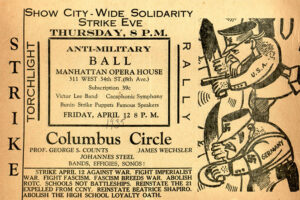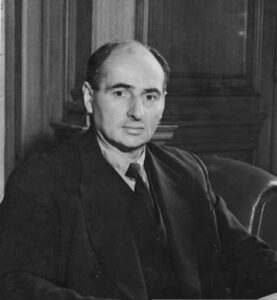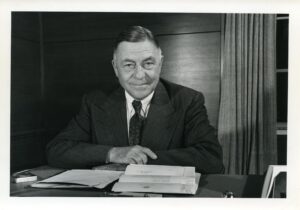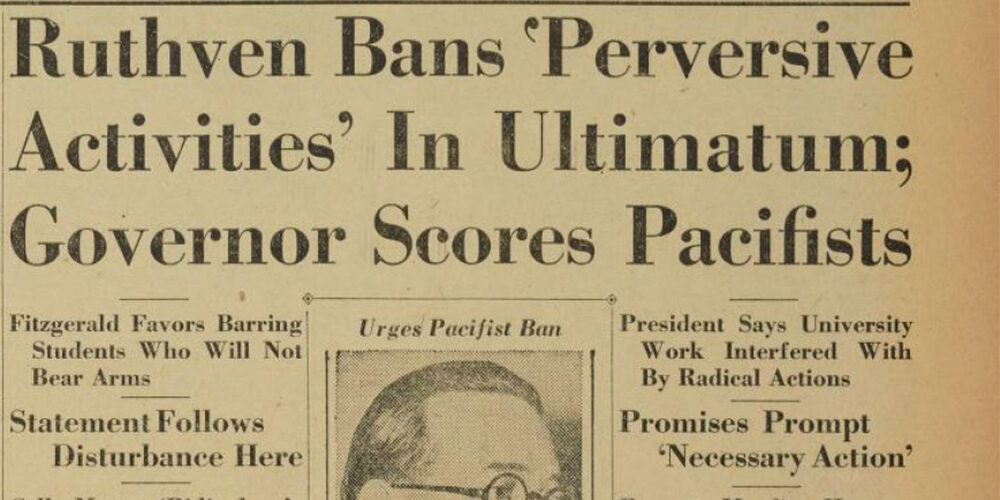The thorn in his side
At first, President Alexander Grant Ruthven watched Michigan’s small cadre of rebellious students with detached amusement. They “have a good time wrangling with each other,” he remarked in a private letter.
But before long, U-M’s leader realized the same cadre threatened to become a thorn in his side.
Ruthven had been president for four years when Adolf Hitler rose to power in Germany in 1933, igniting fears of a second world war. The Great War of 1914-18, entered with the promise of “a war to end war,” was now widely viewed in Great Britain and the U.S. as a monumental tragedy. A movement to preserve the fragile peace in Europe was rising in British universities. The Oxford Pledge, a personal vow never to take up arms for king and country, canvassed British campuses, attracting thousands of signatures.
In the U.S., like-minded students took notice and began to assemble their own antiwar drives — arguably the first significant outbreak of college-student activism in American history.
A strike against war

Pacifists in New York put on an “Anti-Military Ball” at the time of the 1935 “strike against war and fascism.” The artist equated Hitler with Uncle Sam. (Credit: Revolution’s Newsstand.)
In April 1934, students on scattered campuses walked out of classrooms for an hour to take an American version of the Oxford Pledge. These protests were barely heard in Ann Arbor. But as spring 1935 approached, plans for a much larger “strike against war and fascism” were brewing nationwide. U-M’s chapters of the leftist National Student League — communist in its ideology though not run by the Communist Party — and the League for Industrial Democracy meant to do their part.
As on most campuses in the early 20th century, Michigan’s faculty and administrators took their power over student behavior for granted. The term was in loco parentis, Latin for “in the place of parents.” Students were regarded like children in a family. They could speak out against authority only to a point. The First Amendment? That protected college students about as much as it protected defiant 12-year-olds, or so most faculty — not to mention the public — believed.
Ruthven paid lip service to students’ free-speech rights. But he also reserved the right to discipline any student who disturbed the campus peace, showed “immaturity,” or interfered in any vague way with the University’s proper business. That left him wide leeway.
U-M’s leftist students were about to test those boundaries.
The radical in Granger’s Ballroom

The radical John Strachey, once a member of the British Communist Party, rallied U-M students to the pacifist cause in the spring of 1935. He would later be Minister of War under Prime Minister Clement Attlee after breaking with the Communists. (Credit: Wikipedia.)
Tensions first rose that spring when the NSL booked Hill Auditorium for a speech by John Strachey, a radical British pacifist. Vice President Shirley Smith OK’ed it on the understanding that Strachey would speak on “international peace.” But when ads billed the topic as “The Coming Struggle for Power,” Smith said that didn’t sound very peaceful and canceled the reservation. So the NSL recruited local sponsors for Strachey to speak at Granger’s Ballroom on Maynard Street, where he drew a crowd of 1,000 people.
That was just a warm-up. NSL leaders meant for U-M to take a significant role in a more extensive 1935 version of the “strike against war and fascism,” set for mid-April. They scheduled their event for a week earlier, since the national strike would occur during Michigan’s spring break.
Most U-M students were hardly fire-breathing radicals. In a mass meeting at the Michigan Union, 17 student organizations quashed NSL’s plan for students to boycott classes for a day. Not that they weren’t against war. They just wanted “a more conservative demonstration,” as the Michigan Daily put it. Even the Young Republicans were “in favor of any intelligent efforts to outlaw war,” but they “felt that the strike was both futile and uncalled for.”
Instead, plans were laid for a speech at Hill by Robert Morss Lovett, a University of Chicago English professor and a major voice of the pacifist left at the New Republic magazine.
But the NSL’s leaders weren’t going to let the day go by with only a polite lecture by an English professor.
Signing the Oxford Pledge

The right-wing news magnate William Randolph Hearst was hung in effigy by students after William Morss Lovett’s pacifist speech excoriating Hearst. (Credit: Michigan Daily Digital Archive.)
At 11 a.m. on Thursday, April 4, about a thousand students — 10% of the student body — mobbed the center of the Diag for the NSL’s antiwar rally. Some 450 of them took the step the NSL hoped for, signing the American equivalent of the Oxford Pledge, vowing not to bear arms for Uncle Sam.
At 4 p.m., Lovett spoke to an audience of 1,200 at Hill. He denounced the U.S.’ participation in World War I, urged revision of peace terms to assuage German grievances, criticized the Reserve Officers’ Training Corps (ROTC) as a propaganda tool of the War Department, and excoriated the right-wing newspaper magnate William Randolph Hearst as a warmonger.
Finally, that evening, a crowd of student revelers hung Hearst in effigy, branding the media mogul as “Public Enemy #1.”
(Despite spring break, not all Wolverines missed the nationwide protests a week later. At Michigan State, five U-M students and a Unitarian pastor from Ann Arbor, a Michigan graduate named Maurice Wiltse, were tossed into the Red Cedar River by counterprotesters. Wiltse remarked that those who dunked him would not “agree with what was to have been said [at the rally] until they see their decaying comrades on some battlefield of the next war.”)
‘Silly theories’
It took a couple of days for headlines about “red” students to spread around the state. Then Michigan politicians rose in wrath.
Gov. Frank D. Fitzgerald declared: “We should slam the doors on any students who wish to take advantage of higher education offered by their government and then refuse to support their government in time of war. This is no time for a lot of silly theories. The whole matter is ridiculous and has no part in the school curriculum.”
Nobody had said the Oxford Pledge was part of U-M’s curriculum, but other authorities, too, were inclined to blame the faculty, whatever the facts. U-M Regent James O. Murfin remarked, “though I have been assured there is no such teaching … there is no place on the campus of the University of Michigan for professors teaching communistic doctrines.”
Regent Charles F. Hemans urged tolerance, with a twist. “Student radicalism is like a gasoline fire,” he said. “The more you stamp it out, the more it spreads. These students should be allowed a free rein within reasonable limits in order that they can be made to realize how few people are interested in listening to their theories.”
Ruthven cracks down

Alexander Grant Ruthven, the specialist in reptiles who was president of U-M from 1929 to 1951, said he privately shared the views of pacifist students. (Credit: U-M’s Bentley Historical Library.)
Absent the public outcry, it’s hard to know if President Ruthven would have acted so forcefully. He told a fellow president in private that he shared the students’ antiwar sympathies. But he came down hard on the radical ringleaders.
In a public declaration, he said he had no wish to curtail the freedom of speech. But “University work has been interfered with and the reputation of the institution has been called into question recently by perversive activities of a few professional agitators, by certain other misguided persons not connected with the University … and, unfortunately, by a small group of immature students. Continuance of these activities will not be tolerated.”
He toughened the rules for authorizing student meetings and initiated an investigation. That summer, three leaders of the NSL plus one other student, all juniors from the East Coast, were told not to return in the fall — William Fisch, Joseph D. Feldman, Daniel Cohen, and Leon Ovsiew.
Ruthven insisted, “This action has nothing at all to do with the political or social beliefs of the students concerned.” The problem was their “interference” with the University’s proper work.
Good riddance?
Fisch, Feldman, and Cohen fought their dismissal and were rebuffed. When Ovsiew promised to drop his political activities on campus, he was readmitted.
The Daily that year was in the anti-radical mainstream. From New York, the New Republic denounced the expulsions. But the student paper ran a front-page editorial headlined: “Good Riddance of Bad Rubbish.”
The editors predicted the expelled students “will attempt to confuse the issue by bringing in questions of freedom of speech, discrimination, infringement of academic freedom, and the fight against war and fascism.” But “the fact remains they have been asked to stay away because they, as individuals, were bringing only discredit to Michigan.”
Five years later, with war raging on both sides of the planet, the peace movement would rise again at Michigan. (See the Michigan Today feature The Doves of 1940.)
Sources included Robert Cohen, When the Old Left Was Young: Student Radicals and America’s First Mass Student Movement, 1929-1941 (1993); Peter E. Van de Water, Alexander Grant Ruthven of Michigan (1977); James Wechsler, Revolt on the Campus (1935); The Michigan Daily; and a short history of the Oxford Union. Lead image from the Michigan Daily: President Ruthven cracked down on “perversive” peace protesters at U-M just as Gov. Frank D. Fitzgerald was denouncing them. Credit: Michigan Daily Digital Archive)




Susan Wineberg - 1967: 71,75
Wasn’t Raoul Wallenberg here at this time? He may have been inspired by some of these protests!
Reply
Mike Jefferson - 1980
So back in the 1930’s, a significant number of UofM students supported appeasement of tyranny and in effect supported the Nazi cause. Fast forward to 2024 where UofM’s campus where UofM students support endless militarization in conflicts such as those occurring in Ukraine, and once again are champions of fascism in their support of Hamas and the annihilation of Jews.
Reply
David A Griffith - 1998
Mr. Jefferson,
The UM students are not protesting in, “support of endless militarization in conflicts such as those occurring in Ukraine, and once again are champions of fascism in their support of Hamas and the annihilation of Jews,” as you write.
The majority of the protesting students are supporting the right of Ukraine to defend its sovereign borders against an unprovoked Russia. They are not supporting endless militarization.
Again, you misunderstand the majority of the protesters over the conflict between Israel and Hamas. The students are not “champions of fascism,” but protesting in support of the innocent peoples of Gaza and the number of indiscriminate deaths inflicted on them by the Israeli military.
Reply
Alexander Ruthven II - 1971
My grandfather experienced MANY challenges during his tenure as the President. So many of his decisions brought on significant stress for both him and the family. He also had to simultaneously endure challenges in his personal life. However, time has proven that his leadership and decisions were admirable and that he was one of the great Michigan Presidents in oft difficult times.
Alexander Grant Ruthven II
Reply